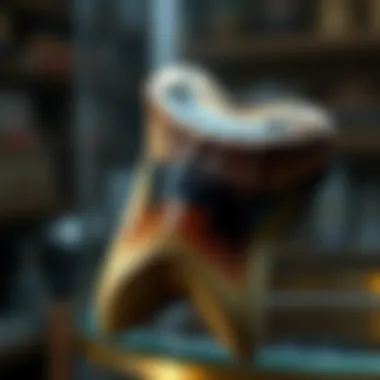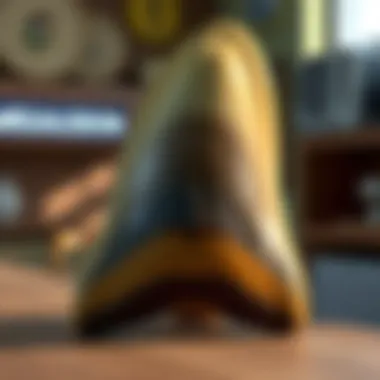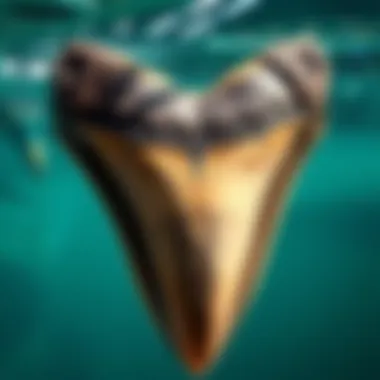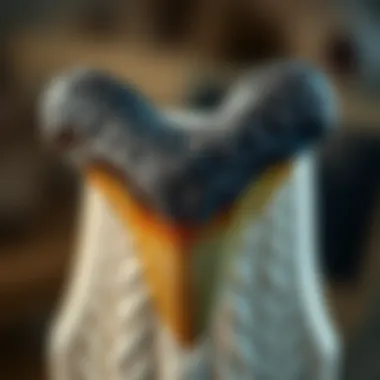A Complete Guide to Buying Megalodon Teeth


Intro
Collecting fossils has grown into a passionate hobby for many individuals over the years. Among these, the megalodon tooth certainly stands out as a prized possession. Not only is this ancient relic a conversation piece, but it also holds significant historical value, representing the great predators that roamed the oceans millions of years ago. As more collectors enter the scene, the demand for authentic megalodon teeth has surged, leading to a bustling market that can be both exhilarating and confusing for newcomers.
In this guide, we’ll peel back the layers of purchasing megalodon teeth, walking you through the essential aspects from finding reputable sources to discerning authenticity and understanding pricing. You’re set to embark on a journey that will illuminate the ins and outs of this captivating area of fossil collecting. Let’s dive right into the foundational steps by discussing the importance of identifying rocks and fossils.
Preface to Megalodon Teeth
Megalodon teeth aren't just objects of fascination; they are gateway symbols to a prehistoric world that stirs the imagination of many. As we embark on this exploration, it is vital to understand what these extraordinary fossils represent and why they have become a coveted collectible in the realm of rock and fossil collecting.
The term megalodon might conjure images of colossal sharks slicing through ancient seas, but it also signifies a deep connection to Earth’s distant past. These teeth, which can measure over seven inches in length, serve as tangible remnants of marine life that once ruled the oceans millions of years ago. They embody both the marvel of evolution and the fragile nature of life on our planet.
Understanding megalodon teeth can greatly enhance one’s perspective when plunging into the world of fossil collection. They have rich narratives behind them, and owning one can feel like holding a piece of ancient history. Collectors are often not just hunting for size or beauty but also for pieces with compelling stories or unique characteristics. This section sets the stage for recognizing what these teeth symbolize in various contexts, from historical significance to personal value in collections. Consider the following aspects when contemplating the purchase of a megalodon tooth:
- Understanding the Depth of History: Each tooth tells a story about its time, an era when these massive predators roamed the oceans with authority.
- The Appeal of Rarity: The rarity of well-preserved megalodon teeth contributes significantly to their desirability. Collectors appreciate the challenge in acquiring these unique pieces.
- The Personal Connection: For many enthusiasts, collecting isn’t merely about possession; it’s about the passion ignited by prehistoric history. The thrill of research and discovery adds layers of excitement and engagement.
In the following sections, we’ll delve deeper into the fascinating world of megalodon. We’ll explore its biology, historical context, market strategies, and what makes these extraordinary teeth such prized treasures.
Why Collect Megalodon Teeth?
Collecting megalodon teeth can be an enthralling endeavor, offering enthusiasts not only an opportunity to possess a piece of ancient history but also a chance to explore the intersection of art, science, and personal passion. These formidable fossils, remnants of the largest known predatory shark, fuel our imaginations and spark a natural curiosity about the past. As such, understanding the multi-layered significance behind the collection could profoundly enhance one’s experience as a collector.
Cultural and Aesthetic Appeal
Megalodon teeth have a distinct aesthetic that attracts many collectors. These teeth vary in size, and the jagged edges coupled with their imposing dimensions can captivate anyone who lays eyes on them. A well-preserved megalodon tooth can be as large as a child's hand, with some exceeding a foot in length. The color spectrum ranges from deep browns and blacks to more muted grays.
Beyond their sheer size, they tell stories of survival and evolution, forming a bridge between past and present. Placing a megalodon tooth on display can spark conversations—offering ample opportunity to impress guests. When one walks into a room and notices such an extraordinary relic, it simply stands out. It is not merely a tooth; it’s an artifact that speaks volumes about the history of Earth’s oceans, adding an element of gravitas to one’s collection. As one collector once stated, "Having a megalodon tooth on my shelf feels like having a doorway to times long gone right in my living room."
Moreover, in today's world, where nature and science often take a backseat, these teeth serve as a tangible reminder of the wonders of the marine world. They serve both as a beautiful decorative element and a conversation starter, merging function and form harmoniously. Collectors, therefore, find joy not only in the acquisition but also in sharing the stories that are wrapped up in these fossils, allowing others to appreciate the grandeur of life that existed millions of years ago.
Educational Value
Aside from cultural and aesthetic significance, megalodon teeth hold intrinsic educational value. Collecting these fossils allows individuals to dive deep into marine biology, paleontology, and even history. Each megalodon tooth serves as a robust visual aid to explain geological and evolutionary processes. For instance, understanding natural selection becomes more tangible when one can physically hold something that has evolved over millions of years.
The learning doesn’t stop at science; engaging with fellow collectors opens doors to discussions about the megalodon’s extinction and the changing ecosystems within our oceans. Identify the diverse locations of where these fossils are found can also lead to broader discussions regarding paleogeography and climate changes over epochs.
For educators, having a megalodon tooth can enhance lessons about prehistoric life, marine biodiversity, and conservation. It can prompt students to think critically about the challenges faced by today’s oceanic inhabitants. Listening to the tales of these ancient giants stirs interest and curiosity among young learners, potentially inspiring future careers in environmental sciences.
In essence, collecting megalodon teeth is not just about the fossils themselves. It's about celebrating a rich history, fueling a sense of curiosity, and fostering a deeper respect for the natural world. As such, the initiative to collect these remarkable relics is significant across various dimensions—cultural, aesthetic, and educational.
Key Markets for Megalodon Teeth
In the captivating journey of purchasing megalodon teeth, understanding the key markets where these ancient relics can be obtained is essential. Each market offers unique advantages and characteristics that cater to various preferences within the collector community. The dynamics of these platforms influence the availability, pricing, and authenticity of the specimens. Whether you are a seasoned collector or new to this enthralling hobby, knowing where to look can make all the difference in your quest for the perfect megalodon tooth.
Online Marketplaces


The digital age has transformed the way collectors acquire megalodon teeth, and online marketplaces are at the forefront of this evolution. Buyers can browse a vast array of offerings from virtually anywhere. Notably, there are three main online venues that stand out: eBay, Etsy, and specialized fossil sites.
eBay
eBay is a giant in the realm of online buying and selling, and its impact on megalodon tooth acquisitions is significant. The platform is known for its extensive range of listings, providing buyers access to diverse toothed treasures. A key characteristic of eBay is its auction format, which can lead to competitive pricing and unexpected bargains. It’s a space where one might snag an authentic megalodon tooth at a fraction of its market value.
However, with the wide variety of sellers, a buyer must remain cautious. It is wise to research seller ratings and read reviews carefully, ensuring that you’re dealing with reputable vendors. The unique feature of eBay is the option to filter searches based on criteria such as price, location, and condition, which allows collectors to fine-tune their purchase according to specific preferences. Nonetheless, the plurality of choices can also be overwhelming for some.
Etsy
Etsy stands out as a creative platform, catering mainly to artisans and small businesses, making it a delightful choice for collectors seeking handcrafted or unique megalodon teeth items. Many sellers on Etsy prioritize the restoration and display of these fossils, engaging with buyers on a personal level. A notable aspect of Etsy is the emphasis on creativity and originality, often leading to one-of-a-kind finds that cannot be located elsewhere.
However, as with all things unique, prices may be on the higher side. The handmade factor increases the overall cost, which some buyers may find rewarding. One must keep in mind that item quality can vary greatly, thus examining seller ratings and detailed reviews is critical to ensure a satisfactory purchase.
Specialized Fossil Sites
For those who seek focused offerings, specialized fossil sites provide an excellent alternative. These platforms are dedicated to fossils, catering to serious collectors and enthusiasts alike. They are recognized for their authenticity guarantees and often feature experts who can provide the provenance behind each tooth. This characteristic fosters trust and transforms the shopping experience into a reliable venture.
Specialized sites may not have as widespread listings as eBay or Etsy, but the benefit lies in the curated selection. Collectors can find high-quality specimens that come with documentation detailing their origins. The unique feature is the trust factor; buyers often feel more confident purchasing from these specialized vendors. However, this assurance may come with a heftier price tag and fewer options compared to larger online marketplaces.
Brick-and-Mortar Shops
The tactile experience of holding a megalodon tooth in hand before buying is still cherished by many. Brick-and-mortar shops offer just that. This section will discuss two popular options: fossil shops and museums with gift stores.
Fossil Shops
Fossil shops provide an intimate setting where collectors can explore various offerings, often accompanied by knowledgeable staff ready to assist. A defining trait of fossil shops is their focus on education as well as sales. Buyers can engage with experts, ask questions, and gain insights into the history and characteristics of the items available for purchase. The opportunity to inspect the teeth in person adds further confidence in authenticity.
Additionally, these shops may host events or workshops, fostering a sense of community among collectors. However, depending on location, the inventory may not be as vast as online marketplaces, leading to limited options.
Museums with Gift Stores
Many museums house gift stores that feature fossils, including megalodon teeth. These stores not only serve as a chance to bring a piece of the museum experience home but also to purchase a scientifically valuable item. A significant advantage is that items sold typically undergo thorough scrutiny for authenticity, adding credibility.
The unique feature of museum gift shops is the blend of education and conservation they promote. Purchasing from these venues often supports museum efforts, which is an appealing bonus for many buyers. However, prices tend to be on the higher side compared to other markets, reflecting the added value and credibility associated with the museum experience.
Fossil Shows and Exhibitions
Fossil shows and exhibitions serve as vibrant hubs for collectors, providing opportunities to connect with like-minded enthusiasts, meet vendors, and even acquire extraordinary specimens like megalodon teeth. These events play a pivotal role in the fossil community, presenting a dynamic atmosphere filled with knowledge-sharing and passion for paleontology. Collectors can find unique specimens often not available in stores or online, further enhancing the pursuit of megalodon teeth.
Whether it’s establishing friendships with fellow collectors or gaining firsthand access to expert insights, fossil shows can enrich the experience of sourcing these remarkable teeth. They also often include educational talks and demonstrations, elevating the relevance of these events even further.
Collectively, these markets illustrate the various avenues available for obtaining megalodon teeth. A strategic approach to exploring these options can lead to rewarding finds, whether one’s goal is to build a personal collection or to simply appreciate the striking beauty of these ancient artifacts.
Identifying Authentic Megalodon Teeth
Understanding how to identify authentic megalodon teeth is paramount for anyone looking to make a purchase. Given the increasing interest in these prehistoric specimens, the market has unfortunately seen a rise in forgeries. Being able to distinguish genuine teeth from imitations not only protects your investment but also enhances your collecting experience. Authentic teeth serve as historical artifacts, offering a tangible connection to the past, while counterfeit specimens can mislead and disappoint.


Physical Characteristics to Observe
When examining a megalodon tooth, certain physical characteristics stand out and can aid in verifying authenticity. Let’s dive deeper into the two most critical aspects: size and shape, color and texture.
Size and Shape
Size and shape are crucial indicators of authenticity. Authentic megalodon teeth typically measure anywhere from 1 to over 7 inches long—though larger specimens do exist. The primary characteristic to look for is the triangular shape, featuring sharp serrations along the edges. A genuine megalodon tooth has a distinctive slant, tapering towards the crown with a wide base. This shape not only tells a lot about the species but also its hunting prowess, reflecting the power of this colossal predator. If you find a tooth that’s too symmetrical or oddly shaped, beware, as it might indicate a forgery.
Unique Features: One unique feature of authentic megalodon teeth is often the natural wear found along the edges. This wear reveals the teeth’s usage—showing that they were once part of a living creature. Moreover, the weight of genuine megalodon teeth is different from those made from resin or plastic; real teeth feel heavier and more solid in hand.
Color and Texture
Color and texture play significant roles in identifying authentic megalodon teeth as well. They usually exhibit a glossy finish, indicative of millions of years of fossilization. Typically, genuine teeth might reflect hues of dark black, rich browns, or even hints of dark gray. The texture can range from a smooth, polished surface to a more coarse feel in older specimens. When you see a tooth that looks overly shiny or uniformly colored, it's a red flag.
Unique Features: One unique feature you might encounter is fossilization markings or mineral deposits that can enhance the tooth's appearance. These speckles or imperfections may indicate an authentic specimen. However, be cautious of overly rugged textures that could point to extensive artificial aging processes.
Common Forgery Techniques
Despite the historical allure of megalodon teeth, the market is not without its pitfalls. Several common forgery techniques pose a challenge for collectors. One prevalent method is the production of replicas using molds from genuine teeth. The replicas can be strikingly convincing at first glance; often, they will be made from resin or plastic instead of fossilized material, which leads to discrepancies in weight and texture.
Another technique involves artificially aging modern teeth or materials, making them appear ancient and valuable. This can include the addition of stains or antiquing processes to deceive the eye. Collectors should always be skeptical of unusually low prices for what appears to be authentic megalodon teeth—if it seems too good to be true, it probably is.
Factors Influencing Price
When it comes to megalodon teeth, price can swing like a pendulum, largely depending on some core factors. Understanding these influences not only helps collectors but also guides prospective buyers in making informed decisions. Whether you're after a trophy piece or a humble addition to your shelf, knowing what drives the cost can save you both time and money.
Size and Condition
The size and condition of megalodon teeth are often the first things that catch a buyer’s eye. A larger tooth, say over six inches, typically comes with a hefty price tag. Why? Simply put, rarity plays a significant role here. Smaller specimens can be easier to find, but an impressive size indicates the tooth's age and history, making it more collectible.
Additionally, condition is paramount. A tooth that's well-preserved, showing minimal wear and fractures, commands a higher price than one that’s seen better days. Collectors often prefer teeth that have not been overly polished or repaired. A natural finish speaks volumes about authenticity and integrity. Remember, a well-preserved tooth isn’t just more attractive; it can also significantly affect resale value.
Provenance and Documentation
Collector wisdom emphasizes the importance of provenance—knowing where the tooth has been and who’s had it before you. Teeth with verifiable documentation or origin stories not only increase confidence but also inflate their price. Documentation could include scientific records, previous sales receipts, or even photographs of the tooth in its original context.
For instance, a megalodon tooth found in a well-known fossil-rich site like North Carolina carries more weight than one without such background. This ties back to the idea of trust in the marketplace. If the seller can present solid evidence of the tooth’s history, it alleviates buyer concerns about authenticity and forgery.
Market Trends
Like any collectible, the market for megalodon teeth can rise and fall based on demand and availability. Popular culture influences can have a surprising impact. For example, if a blockbuster film features a megalodon, suddenly, everyone wants a piece of that prehistoric giant. Prices can surge and fluctuate in response to current events, such as documentaries or scientific discoveries related to the species.
It’s vital to keep your ear to the ground. Engaging in communities on platforms like Reddit or specialized fossil forums can help you gauge the pulse of market trends. Additionally, following sales data from auction sites can provide insights into pricing shifts over time.
Always stay informed—you never know when those price swings might just come back to bite you!


By staying abreast of these factors, collectors can navigate the market with confidence, ensuring they get value for their money while enhancing their collections.
Care and Preservation of Megalodon Teeth
Megalodon teeth are not just remarkable relics of prehistory; they are also delicate specimens that require careful attention. Proper care and preservation can significantly enhance their lifespan, allowing collectors to enjoy their beauty for many years. When you invest in a megalodon tooth, you're not only acquiring a piece of history but also committing to maintaining its integrity. Understanding preservation techniques can help ensure that these artifacts retain their value and appeal.
Cleaning Techniques
Cleaning megalodon teeth is a delicate matter. While they can look stunning with a bit of shine, using harsh materials or aggressive cleaning methods can cause more harm than good. Here’s how to effectively clean your fossils:
- Gentle Washing: Start by rinsing the tooth under lukewarm water to remove loose dirt. Avoid using hot water since it may harm the enamel.
- Softer Brushes: If tougher grime sticks, use a soft-bristle toothbrush or a microfiber cloth. This approach allows for a gentler scrub without scratching the surface.
- Non-Abrasive Cleaners: For stubborn stains, use a mild soap solution. Steer clear of bleach or ammonia, as these can severely damage the fossil.
Sometimes, even the air can have a dirty surprise. Humidity and dust can accumulate, so giving your collection a periodic clean will go a long way. Remember, preserving the natural state and appearance of the tooth should always come first.
Storage Recommendations
How you store your megalodon teeth can be just as critical as how you clean them. Proper storage protects them from environmental factors that can cause degradation over time. Consider these strategies for effective storage:
- Display Cases: Investing in a UV-protected display case can shield your fossils from sunlight and dust while allowing you to show them off proudly.
- Temperature and Humidity Control: Keep your collection in a climate-controlled room. High humidity can lead to mold and deterioration, while extreme dryness may crack the fossils.
- Individual Wrapping: If you have multiple teeth, wrap each in acid-free tissue paper before placing them inside the case. This helps prevent scratches and any chemical reactions that could occur between different specimens.
In essence, a bit of love and proper care goes a long way when it comes to megalodon teeth. With the right cleaning techniques and smart storage solutions, you can ensure your collection remains as captivating as the day you acquired it.
Building a Collection
When it comes to collecting megalodon teeth, just grabbing any old tooth off the shelf won’t cut it. Building a collection is more than just an act of acquisition; it's about shaping an assemblage of stories, histories, and personal connections. Collecting megalodon teeth offers enthusiasts an opportunity to explore the past on a profound level while also engaging with a thriving community. Whether you're a seasoned collector or just starting out, understanding the elements that contribute to a meaningful collection can enhance your experience.
Setting Personal Goals
Before diving headfirst into the world of megalodon tooth collecting, it’s essential to set personal goals. Ask yourself specific questions that will guide your journey:
- What motivates you to collect? Find a driving reason; whether it's for educational purposes, personal passion, or investment potential.
- What types of specimens interest you? Are you drawn to unique colors, sizes, or even where they originated? Defining your focus can help narrow decisions down the line.
- How much time and resources can you commit? Realistic goals regarding time and finances can prevent feelings of being overwhelmed or stretched too thin.
Setting these kinds of goals allows you to carve out a path that feels personal and curated rather than random, building a collection that truly reflects your interests and passion.
Engaging with the Community
Community engagement is a cornerstone of successful collecting. Connecting with fellow fossil enthusiasts can broaden your understanding and enrich your collection. Here are some ways to immerse yourself in the community:
- Join Online Forums and Groups: Websites such as Reddit and various Facebook groups are invaluable resources. They allow collectors to exchange tips, share finds, and discuss trends.
- Attend Fossil Shows and Local Events: Finding local exhibitions or fossil shows not only provides opportunities to purchase specimens but also to meet like-minded individuals who share your passion. Often, these gatherings feature expert talks that can deepen your knowledge.
- Volunteer or Participate in Field Trips: Engage with organizations dedicated to paleontology and geology. Getting involved with field digs or educational programs can offer hands-on experience and expand your connections.
Engaging with others in the field can lead to new insights and sources of inspiration, enriching your collecting experience beyond simply accumulating specimens.
By taking the time to set personal goals and actively engage with the community, your journey in building a collection of megalodon teeth can become not just a hobby, but a significant part of your personal narrative. These interactions foster relationships that can lead to opportunities for trading, learning, and finding unique pieces for your collection.
End
As we draw the curtains on this comprehensive exploration of acquiring megalodon teeth, it's essential to reflect on the myriad dimensions this fascinating pursuit entails. Collecting megalodon teeth is not merely a hobby; it's a blend of passion, education, and community engagement that connects enthusiasts to Earth's prehistoric past.
When deciding to dive into the world of fossil collection, particularly megalodon teeth, consider the benefits it offers. For one, these items are not just visually striking—they serve as tangible connections to a bygone era, representing the majesty and power of these ancient creatures. Furthermore, owning a megalodon tooth often ignites a thirst for knowledge, prompting collectors to learn about the history of sharks, their ecological significance, and the processes involved in fossilization.
But enter this world with your eyes wide open. The market can be a double-edged sword; understanding the subtleties of authenticity and pricing is vital. As noted earlier, being well-informed helps you distinguish between genuine specimens and expertly crafted fakes. Keeping abreast of market trends and developing a keen eye for quality can pay dividends down the line.
In addition to personal enrichment, your foray into megalodon tooth collecting can foster connections with a diverse community. Whether through local clubs, online forums, or fossil exhibitions, sharing experiences and insights can significantly enhance your collecting journey. Plus, the camaraderie found within this niche community is often cited as one of the most rewarding aspects of the hobby.







